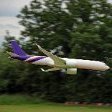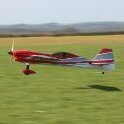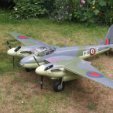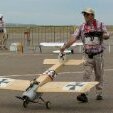Leaderboard
Popular Content
Showing content with the highest reputation on 25/01/24 in all areas
-
6 points
-
My Mate Bert Baker has inspired me to a world all that’s Stampe & has got me involved within the yearly shows of late I’m a proud owner of an old Stampe I managed to procure with the aid of Berts knowledge 3years ago it had an old OS 91 that was marginal in its flying ability so have since fitted a DLE 35 this has transformed its flying ability not mine though but it has made judgement calls for landing & take offs easier anyway I digress ……. this is all leading to a small project I under took last weekend with in my workshop as I have a new laser cut Stampe kit under construction for a while now & with some newly installed equipment within said workshop I have managed to 3d print & laser cut the parts for the dash boards that I thought I would share with you all……. again being inspired & prodded by Bert to do so here are some images of the project I hope you find my first ever post informative4 points
-
I'm surprised it wasn't sold to Amazon as a base for launching squadrons of their new mass delivery personnel drones 🤣 Live - Fly - Repeat 😉 Thank you, I'm here all week...3 points
-
Coming from a full size flying and gliding background, when I re-started model flying back in 2000, it felt perfectly natural to kept a log of all my training flights. This had date, model, and any comments e.g. which lesson and how well I thought I'd done. Once I went solo, I maintained the log and still do. I record trim setup changes whenever they occur e.g. CG position, wing incidence, rates, mixes as well as comments on how I flew and what I am having problems with - oh and if the wind speed / direction. When I passed my FW B, I was able to look back and see that I had flown 80 flights with almost always 2 B schedules per flight so a total of 160 Bs flown to get to the consistency I needed to feel sure I would pass. I did at my first attempt but was asked to re-do one of the rolling manoeuvres before the Examiner was happy. That's a useful story to tell folks who want to get a B. OK, so I'm a slow learner but I was starting from a low level of skill. For my electric flight, I have a strike off sheet that goes from 1 to 100 so that I know how many cycles that pack has had. One diagonal means the pack has been discharged and a cross, or 2nd diagonal, that the pack is fully charged. I also keep a record at home for each flight pack or how much charge went in, the IR and the cell voltage difference. This also provides a cross check with the battery pack strike off list. I used to do an annual tally of which aeroplane I'd flown, including number of flights and total duration and kept a running total of total flights and hours flown. That fell away once I focused on flying almost just 1 aircraft, my current competition bird. I find it useful to see how many schedule flights I've flown in the run up to competitions and for the year. It's never as many as I would like, of course. I just use paper records and print off the forms as I need them. I find that filling in the log after every flight helps me to think about how I flew and what I need to work on. It's useful sometimes to look back at previous history but that happens only very rarely. Why do it? Habit!3 points
-
My wife is due a 38 year (married) service. Do you think the Repair Shop would take her on? I still have an emotional connection and they don't make them like her anymore 🤣3 points
-
I think youve missed the point of the show. Theres a story and emotional connection to the objects that you can no longer buy and amazingly skilled people repairing them. Why would anyone want to watch someone repairing a washing machine that you can buy new anywhere. If needed you can see that on you tube.3 points
-
Good read again, sorry the paper copies only gonna be once a year, but understand the decision.2 points
-
That's an impossible question, as too many other factors, many of which have been listed in this thread. As you've correctly stated, it's all down to assessing and managing risk. However how much risk is tolerable and how is it assessed? For models over 250g the rule is 30m. OK, reduced to 15m if a specific risk assessment and mitigations are in place - but do we really want to go there - I certainly don't. Key is to have complete control of the model and adequate separation from other users. I have a small park nearby, a couple of hundred metres away. Village hall grounds. 60m by 60m. I'll sneak a few flights in with a 50g guarded prop quad there, nothing bigger. I probably don't fly further than 15m away. If anybody else enters the space I pull in very close, within 5m, and usually land. The "anybody else" is normally accompanied by a child, a dog or both. A larger country park is about 600m by 600m. When it's quiet, I'll fly a 1 m wingspan sub 1 Kg foamy, but way away from anybody else, and within 50m of myself. Sometimes a 500mm Nutball. When it's not quiet, I'll not fly there.2 points
-
No one has mentioned football fields, plenty about and usually deserted, think that would be my definition of a PARK Mention of method of home heating pricked my ears up, although well off topic, a friends landlord has obtained a huge grant to convert all their cottages to air source heat pump. He is spending around £20 a day on electric , probably more than if pure electric heated.2 points
-
Well, looking back at the responses in this thread, I'm heartened to see that quite a few of my fellow flyers do log their flights, or take part in some aspect of record keeping and creating data which they find useful in their hobby. I totally get it that some flyers prefer not to do so and that is completely fine. It's entirely a personal choice. I thought it would be interesting to see the response from the much larger, international community on RCG and it couldn't have been more different - overwhelmingly, with just a few exceptions it was very strongly anti-logging, sometime really aggressively so and that did surprise me somewhat.2 points
-
The receiver in by far my largest, most complex and delicate foam plane is.... A Lemon 6ch. ☺️ The elevator plug has to be inserted on assembly.2 points
-
There's only one type of WC log 😉2 points
-
Steve, you might consider shortening the nose a little. The original balanced with a 70's style .60 2 stroke engine which were pretty lightweight compared to your Saito FG21. (I averaged the weight of most typical engines from the period by checking reviews at the usual websites) I did the calculations for fitting a Saito FA-100T to my DB short kit and came up with the conclusion that about 20mm reduction in the distance from the CG to the front former would be required to avoid adding lead to the rear end (even after servo's and flight battery moved aft a bit. My rudder and elevators are also built-up (as opposed to sheet) with pull-pull controls so already lighter at the rear end. The Mighty Barnstormer is a great design, best of luck with your build. * Chris *2 points
-
If your hobby was travelling to your flying site, I reckon that'd be a good idea.2 points
-
My thoughts then turned to the battery box. I am going to be using the ally spinner and 4000mah batteries. From what I have read, this combo can come out nose heavy. With this in mind, I decided to lenghten the battery box as follows. I had to remove about 5mm from the sides of the original battery box as the were preventing the hatch from being slid off sideways. I had to remove the cross piece on the crutch as it was preventing the battery from sliding in. More later...1 point
-
1 point
-
Rich, just for you. This was its maiden too! https://www.youtube.com/watch?v=dY1IkLImlHI More a rugby field than a park.1 point
-
Understood @Lipo Man. Thanks. I really have cocked-up a bit on my first EDF attempt. But this could be good news because in version 2 I can significantly reduce the cross-sectional area of the back end of the exit tube. This will leave sufficient room at the rear fuselage to mount the elevon servos, relocating them from the front fuselage and removing the need for snake links. Then I can use a slightly heavier higher capacity lipo to rebalance at the CG. I will first fly as is. Then I may experiment by adding a short convergent nozzle at the exit. In a later version I may also incorporate a vectored thrust nozzle. It's all fun at the fun factory.1 point
-
1 point
-
£25K per edition when posted? - simply not feasible. So far only 1500 members requesting a hard copy so the change should have been made years ago and would have saved a fortune. Well produced as always, but not what most members are interested in and want to read in detail. Having said that I do hope everyone at least reads Ian Pallister's somewhat sobering article. A shame but that's the fact of the matter.1 point
-
Yep, only one hard copy a year gratis from now on. Wrong choice I feel but I also understand why. However £10 for hard copies was it ? I will make do with the digital copy.....1 point
-
1 point
-
"Can I make this flight safely" has long been the case, and models larger than a Riot have been flown many a time, and rightly so.1 point
-
Heard nothing but good reports from Lemon users myself.1 point
-
I have used a few Lemon Rx, both stabilised and conventional flavours. Have I had an unexplained crash - yes - but the Tx was later found to be faulty, so in retrospect, I don't think that the Lemon was at fault. Now that I have a new (multi protocol) Tx, I may well dig it out of the drawer (I never throw anything away - why?) and give it a thorough check before trying it out on a cheap foamy. I would have no hesitation in using Lemon rx in the future, the Gen2 stabilised in particular, but will probably also use an additional satellite rx, particularly in larger planes. Also the Lemon Rx designer is active over on the RCGroups forum (username fmak) and he seems very pro-active if there is any chance of a faulty unit, which does inspire some confidence. Kim p.s. I'm also thinking of getting a Lemon tx module for my Taranis, to use it as a back up to my Radiomaster TX16S Mk2 on the DSMX protocol 'just in case'1 point
-
I spent several years thrashing the pants off a Precision Aerobatics Addiction, and a few GWS foamies at sports fields. Made me a much better overall flier.1 point
-
Actually it was nearer 15 mins be flight so, on that basis, I make it 20 hours. The other point I would make is that I only ever flew my Wot 4 during that time and only ever flew the B schedules. It was a case of needing the B as soon as possible so that I could get into competitive aerobatics. I would never have know this had I not kept the notes that I did. The notes also showed that the most difficult manoeuvres were the 2 rolls. Eventually, I set up a low rate on the ailerons that gave a constant rate of roll with the stick hard over, and then I only had to work on timing the elevator application. A bit later on, when I was challenged on the very low roll rate being more akin to a slow roll, I measured the roll rate and found that rolling right took 2.5 secs per roll while rolling left took 3 secs per roll. Rolling with the engine's torque was faster! I would never have found that out since the difference in roll rate was not at all obvious to the eye! Funny what you learn with a bit of data!1 point
-
...presumably preferring to advance the hobby by means of hearsay and Chinese whispers, and it's all Spektrum's fault anyway. How dare you attempt to make anything better through use of data ! The funny thing is, I didn't once notice the log-keepers saying how daft not keeping a log was, yet plenty came back the other way (in a good-humoured way on this forum - but flak nonetheless!) Great thread leccy - it's been a really interesting read.1 point
-
Made a start with the covering and using MacGregor iron on film for the first time. So far so good, made it round the curves at the nose ok with a few cuts to help. One minor niggle, where you slightly overlap sections as when covering a fuselage for example, the adhesive bleeds out from the overlapping edge onto the finished film, leaving a white line along the length of the overlap. Iron is set to recommended temperature as per instructions so I don't believe it's too hot. Fortunately, I've found it can be cleaned up with meths so it doesn’t permanently ruin the finish, however, never had this issue with any other iron on film; on the plus side it’s considerably cheaper than some other options. Progress so far...1 point
-
Not sure if it will be out this year Alan as work & home come first I have been slowly albeit very slowly it’s making Bert fall asleep with how slow the build is going I have so far put it together fuz tail plane & fin all constructed so next in the agenda is wings one day soon1 point
-
That is completely reasonable and is pure common sense - could easily apply to riding a bicycle or operating machinery.1 point
-
Having googled the well known model engine designers such as Lawrence H Sparey and Edgar T Westbury, it doesn't appear to be one of theirs. The general style of the engine to me puts it somewhere in the late 60's to 1990s, although that is just a gut feeling. An enquiry on the Model Engineer Forum may get a result, or an enquiry to Adrian at https://www.adriansmodelaeroengines.com/catalog/ may help, although he has been hospitalized lately.1 point
-
Isn't the clue to the make in the title of the photo? - "Handmade Model Plane Combustion Motor" Dick1 point
-
The 6 channel I ordered are single but I also ordered a couple of dual 7 channel. I think I'll try one out on my FMS supercub when they arrive. Toto1 point
-
One thing I would advise before starting construction is to work out how to fit the wing bolts - from top or from underneath. I have a Barnstormer 63 ( built by someone else ) and the wing bolts are inserted from underneath which needs a table or stand to get the wing bolts in. And it's easy to crossthread from an awkward position. If I had built the model I would have put the wing bolts in from the top and then it would sit on the ground and the bolts inserted downwards - much easier. I would have tapped the dural cabane struts to take the wingbolt thread. Once the struts have been drilled clearance size for the bolts it's too late to tap them! Note that taps are really quite cheap if you just need one size - perhaps M6 or 2BA - and only a taper tap is needed. Tracy Tools are good suppliers - an M6 tap will be hardly any dearer than buying 4 captive nuts which will no longer be needed.1 point
-
I would not use them for anything that flies! Tested with two DX8 gen 1's on two Lemon 8 channel RX's with exactly the same result (RX's bought at different times). TX and RX bound and passed range check. Tested at the flying field with no model, just RX battery and 3 servos. I then decided to walk across the flying field with the TX while my wife watched the servos moving and about 100 m in a arc around position of the RX it lost signal. I have flown plenty of models on DSM2 and DSMX with both TX's and not had any issues. This was a lightbulb moment as one of the RX's had been in a TN small balsa model that had crashed a few times (had a wicked tip stall) and assumed it was pilot error due to loss of orientation, but the arc of lost signal coincided with the non landing crashes. First point is that once I now I know there is an issue then from a safety perspective I can't use them and secondly I am not prepared to let any model of any value lawn dart itself due to a known issue. Lots of other people with different TX models and RX's have not had issues, but not in my case with two TX's and two RX's1 point
-
I've just had a quick check of my logs (shout out to leccyflyer's current topic!) and the 4 Zippy batts in my 1st post have each had 333 cycles in just one plane (Pilot NG, 1332 flights) in the last 30 months, plus whatever else they've flown on top of that. They've never seen 4.18v. They haven't had much of the 4C charge treatment yet though - all of that has been on the 3300s @ 125 cycles each over the late autumn & winter. When I started in 2015 I used to think I'd be happy if a LiPo lasted 100 cycles. Clearly that requires updating! At the very least, those £40 Zippy packs have done 400 flights each so I'm very happy at 10p per flight (+2p per recharge) - and that's assuming that they've all died today, which they haven't. They appear to be in better condition now than they've ever been. I can't explain it but I'm beginning to think some of the golden rules need updating, or relaxing a little. I think the 4.17v max charge is a lot of it, and the best thing about that is it makes absolutely no difference at all to your flight time, because if you're flying your batts down to the last 0.03v then that's why your batteries are knackered. Does anyone else have an opinion on them only being fully charged for 10 minutes, or is that a red herring? Chemistry was never my strong point but if you took the mantra of "don't leave them charged up" to its logical conclusion, you'd only charge them immediately before use. I didn't really set out with doing that in mind, it's just a by-product of the new routine. But I like it. Two other things occur to me: I like to have at least 6 flights, which meant 6 packs. Then when I started flying 12S it meant 12 packs, which could cost almost as much as the plane. It was a bit like running a care home for batteries too. Now 4 packs get me a whole day at the field flying 12S. If the new routine happens to be a better way of managing them then that's a win-win. We'll see if the high C charge rate kills them but I've done 125 charges on each 3300 pack now, and they had a couple of hundred cycles on them at 1C to begin with... how many cycles do you want for £50? If you do fewer flights of a day then just knock the charge rate back to suit your style of flying. Often there's only Russ & me at the patch so we like to bang out the flights alternately (so we could actually get away with just one/one set of batts, rather than two). If your circumstances only allow one flight an hour then you can do this and still stay at 1C. The extra available speed is there if you need it. I can't explain enough how useless I am at making things, so if anyone is sitting there thinking "It's all well and good for him being able to do that" then think again. I was insanely proud of myself that day. I'm not even very good at assembling ARTFs. I'm quite a good pilot though!1 point
-
No thanks I didn't realise so many people flying had OCD 😂, now where was I, 8h22, facebook 3 comments 7minutes, RCM&E 1 answer at 8.32 am,,,,1 point
-
A lot of people have absolutely no idea about anything mechanical or remotely technical of any kind. There is a channel on YouTube called Just Rolled In where mechanics submit videos of things they found wrong with cars bought in by customers. Most of them are in America, but I’m sure the same kind of things happen here in the UK as well. Watching them I’m never quite sure whether to find them amusing, or be horrified by some people’s total ineptitude.1 point
-
All done and dusted! We now have a grill that works. The hardest bit was replacing the single screw inside the front of the oven at the top. It holds both the element and what I assume is a heat shield above it. The old problem - as soon as you get near the point where the screw should enter the hole and start the thread, you're working blind because the heat shield hides the hole. I overcame it by putting a thin screwdriver through all the holes first to get the location, then instructing my helper to hold everything in place while I withdrew the screwdriver and fitted the fastening screw (one of those funny heads they use to stop users repairing their products). Worked first time!1 point
-
I enjoy the engineering articles in RCM&E, they are nice examples of where our hobby can be enhanced by application of model engineering techniques. They have also always been a part of RCM& E for decades - Brian Winch and Alex Whittaker covered a lot of aeromodelling-relevant model engineering, Danny Fenton has some excellent model engineering content in his scale building column and it's great to read my pal Tim Hooper's recent forays into machining , milling and other aeroplane related projects.1 point
-
Jeez, so much negativity. It's extra choice so just embrace it for what it is, and realise that in all things it's 'caveat emptor'. Regarding spares, the same applies to EFlite, Ripmax (as was), FMS, Hangar9.........1 point
-
And I attended a warbird meeting with around fourty modellers. Some showed their projects, I took the Whirlwind with me, including building material, books and some plastic models as a size comparison to a Spitfire and Fulmar. Merry Christmas everyone 🙂 Timo1 point
















